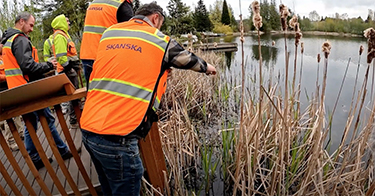|
Subscribe / Renew |
|
|
Contact Us |
|
| ► Subscribe to our Free Weekly Newsletter | |
| home | Welcome, sign in or click here to subscribe. | login |
Construction
| |
 |
March 28, 2024
Five environmental factors influencing construction in 2024
Skanska USA

Chen
|
The built environment accounts for nearly 40 percent of carbon emissions globally, with 11 percent embodied in construction materials and 28 percent stemming from building operations.
That’s why Skanska is working hard to achieve the climate targets we’ve set globally: 70% emission reductions by 2030 (including both from our own operations and from the value chain in development projects), and net-zero by 2045.
To get there, we constantly assess our business for areas of improvement, look at local, state and national policy and legislation, and engage with our clients to help them meet their own climate goals. As we look at the year ahead and beyond, here are five key environmental factors that are driving our business (and much of the industry) forward.
ELECTRIFICATION
All three west coast states pledged to end sales of new gas and diesel-powered vehicles by 2035, meaning new vehicles will need to be tailpipe emission-free from that date forward.
We anticipate many companies with fleet vehicles to begin transitioning to EVs and there likely will be a requisite need to construct or retrofit fleet maintenance facilities to adapt. Skanska has already begun shifting our own fleet to EVs, adding some all-electric Ford F-150 Lightnings to our fleet in Portland, where we’ve become a member of the local Fleet Decarbonization Coalition. Additionally, we have participated in a few pilot programs to test the viability of electric heavy-machinery on jobsites.
It’s not just cars; buildings are going electric, too. Many clients are trying to go fully electric with their buildings to hit sustainability goals, and it’s our job to help them figure out how best to do that.
Incentivizing this practice, cities and states throughout the country are introducing Zero Emission Building Ordinances and other policies to phase out fossil fuel-powered buildings. As of today, 140 state and local governments have implemented policies across a dozen states impacting a combination of new construction and remodels/renovations for commercial, multifamily, public/municipal and single-family use.
ALTERNATIVE FUEL STANDARDS
As with new electrification standards, Clean Fuel Standards have been enacted in Washington, Oregon and California. These various pieces of state legislation have given access to more affordable pricing to companies like Skanska, which has been using lower carbon options like renewable diesel for years with some of our heavy construction equipment. We were the first contractor to use renewable diesel on a major civil project in the state of Washington, the L300 Lynnwood Link Extension light rail project for Sound Transit.
Renewable diesel, which is different than biodiesel, comes from 100 percent renewable feedstocks such as canola, tallow or used cooking oil. It offers a more environmentally sustainable alternative to petroleum-based fuel, reducing tailpipe greenhouse gas emissions by more than 90 percent, and lifecycle greenhouse gas and air pollutant emissions by 60-80 percent depending on the feedstock.
Reduced tailpipe emissions means cleaner air for our trade workers operating and working near the heavy equipment using the fuel, and cleaner air for the communities in which we build. Because of the high Cetane value, renewable diesel also burns cleaner, reduces fuel consumption and lowers engine noise and engines that are easier to start in the cold.
WILDLIFE PROTECTION
When we build, we want to ensure that we’re building safely and ethically. That’s why ensuring wildlife protection and water quality practices on our jobsites is critically important.
Salmon-Safe is one of the country’s leading organizations on implementing practices and developments that protect water quality, maintain watershed health and restore habitat. Skanska is a Salmon-Safe accredited contractor in both Washington and Oregon, which recognizes excellence in water quality protection practices. We are proud to work with both public and private sector clients to help certify projects as Salmon-Safe.
Additionally, as part of the I-405 Brickyard project for the Washington State Department of Transportation (WSDOT), Skanska is building six fish passages that will have a direct impact on salmon and steelhead in the Sammamish River. Among other benefits, opening habitat allows more fish at all live stages (including juveniles who aren’t yet strong swimmers like adults) to access important spawning and rearing grounds, including areas that have been inaccessible for years.
Through design innovations, we have identified opportunities for a 10 percent reduction in the total length of the fish passages needing to be built, creating additional open channel, promoting natural habitat and reducing impact to the stream buffer.
Also reducing impact is the process by which we will build the fish passages — next to existing culverts. This will allow construction to occur outside fish windows, the time each year when in-water construction is allowed due to the unlikely proximity of migrating salmon. We will connect gravity bypasses to existing streams during fish windows so construction staging areas can be set, and work can occur year-round without having as much impact on streams.
We will also eliminate the use of barges and temporary structures in the Sammamish River through controlled demolition, will use both physical barriers and debris netting to keep debris and slurry out of the river, and will use pre-casting, pre-fabricating and pre-painting of elements that will be placed over water to reduce construction time and risk to the Sammamish River.
EMBODIED CARBON POLICY
Most companies are good at quantifying their operational carbon footprints, but many clients, especially those in the private sector, are asking us to help them address embodied carbon.
In fact, embodied carbon policy is popping up all over the country and throughout the world as governments tackle this important issue. We see a mix of voluntary (with or without incentives) programs, regulatory frameworks, agency-led initiatives, action plans, pilot programs, education and training, and more, and it’s becoming more and more widespread.
There are ways to deal with embodied carbon. Back in 2021, the Rocky Mountain Institute and Skanska released a report laying out a framework for reducing embodied carbon in new construction for little to no cost. The study, called “Reducing Embodied Carbon in Buildings” used Skanska case studies looking at the emissions associated with building materials and construction, helping conclude that materials choices, including lower-carbon concrete, could significantly reduce embodied carbon with little if any budgetary impact on a project.
Skanska now invests in providing initial embodied carbon assessments on every new construction project over 53,000 square feet using the Embodied Carbon in Construction Calculator (EC3), a product co-created by Skanska with industry partners. Use of the EC3 tool over the past few years has shown that a 30 percent reduction in embodied carbon is typically achievable for little or no cost. EC3 is available free and open source at http://www.buildingtransparency.org.
SUSTAINABLE AVIATION FUEL
We’re looking at our own travel practices to identify ways we can further reduce our carbon footprint. We partnered with Alaska Airlines to purchase the airline’s sustainable aviation fuel (SAF), making Skanska the nation’s first General Contractor to invest in SAF with the airline. The investment will compensate for the Scope 3 business travel emissions from the domestic and international travel of Skanska’s U.S. Sustainability Team for 2024.
Made from a variety of resources including waste materials such as forestry residue and used cooking oil, or carbon recaptured from the air, SAF is a certified drop-in fuel that meets all jet fuel standards, and produces up to 80 percent fewer CO2 emissions on a lifecycle basis.
Our investment today is a start both for Skanska and what we hope is for the entire construction industry. As we work with clients across the country on maximizing their sustainability goals, we want to ensure we are taking one more step to impact ours.
When looking towards a sustainable future, it’s important to remember that there is no single solution, no panacea. We must cast the net wide and look for a variety of ways to better our industry, better our construction practices and better our planet.
Mark Chen is National Carbon Manager for Skanska USA.
Other Stories:
- Centering equity, reconciliation and community in coastal adaptation
- Eastside cities partner for climate action
- Reclaiming our shores
- Buried treasure: harnessing waste heat for a cleaner future
- Floating wetlands strengthen urban ecosystems and community engagement
- A park for all people — and the environment
- Planning for a rainy day, every day



